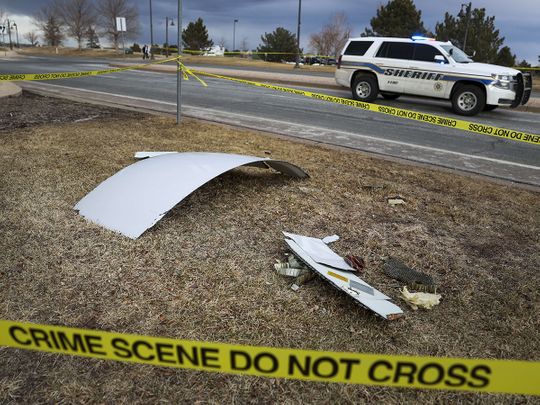
New York: An explosive engine failure that showered debris over a Denver suburb prompted authorities in Japan to halt flights using Boeing Co. 777 aircraft and spurred US regulators to order emergency inspections of engine fan blades.
The US Federal Aviation Administration ordered the checks after examining a hollow fan blade that failed, the agency said. The inspections apply to 777s equipped with PW4077 engines made by Raytheon Technologies Corp.'s Pratt & Whitney division.
The incident on United Airlines Flight 328 from Denver to Honolulu took place shortly after it took off with 231 passengers and 10 crew members. The plane landed safely back at Denver and nobody was injured by the falling debris.
Footage of the burning engine was filmed by a passenger aboard the flight, while people on the ground captured scenes of the plane overhead and scattered aircraft parts near houses.
The scare comes at an extremely sensitive time for the global aviation industry, which has been plunged into crisis by the coronavirus pandemic and its impact on travel. Boeing is only just dusting itself off from the nearly two-year grounding of its best-selling 737 MAX following fatal crashes in Ethiopia and Indonesia, while Pratt has faced separate issues with its geared turbofan engines on Airbus SE A320neo jets, particularly in India.
Engine issue
Two fan blades were fractured on the United flight, the National Transportation Safety Board said. Most of the destruction was contained to the engine and the plane suffered only minor damage. United said it will voluntarily halt operations of 24 of its planes while the FAA order is carried out.
While the incident doesn't suggest broader problems with the 777, it adds another urgent issue to Boeing's to-do list only just after the 737 MAX was cleared to fly again in markets including the US and Europe. The company has halted deliveries of its 787 Dreamliners to check for manufacturing flaws.
- The 777 is distinctive for its hulking turbofans that are about as wide as a 737 jetliner cabin.
- The PW4000-112 engine debuted with the first of the 777s to fly in 1995, and was also available to customers of the later -200ER and -300 models.
- In 1999, Boeing awarded General Electric Co. an exclusive contract to power newer, longer-ranger versions of the 777 with its GE90 engines and eventually phased out the Pratt offering.
Systems check
"We recommended suspending operations of the 69 in-service and 59 in-storage 777s powered by Pratt & Whitney 4000-112 engines until the FAA identifies the appropriate inspection protocol," Boeing said in a statement, adding that it supports decisions by the FAA and Japan's Civil Aviation Bureau to temporarily ground aircraft powered by the engines.
Airlines in the US. Japan and South Korea operate 777s with the PW4000 family of engines. United is the only US carrier with that combination. A Japan Airlines Co. 777-200 with the engines suffered a similar failure on December 4.
Spokespeople for Japan Airlines and ANA Holdings Inc. said Monday they've grounded their 777s following the transport ministry's order and are using other aircraft, while South Korea's transport ministry said it was looking into the issue.








